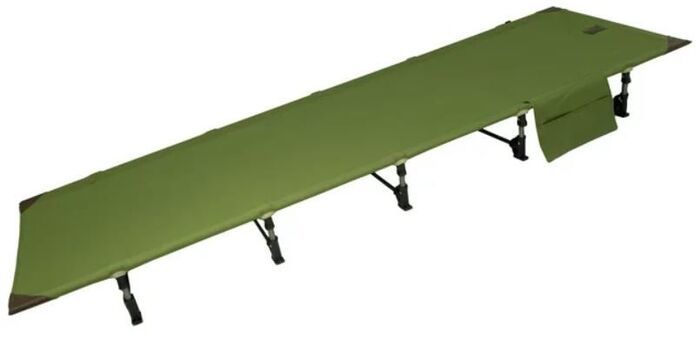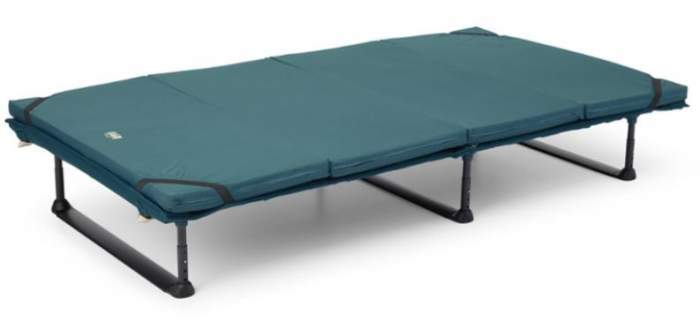This article provides a comprehensive guide to eco-friendly camping cots, covering everything from choosing the right cot to caring for it responsibly.
Introduction
As an avid outdoors enthusiast, I’ve observed a significant shift in the camping gear market. More and more campers are now opting for sustainable equipment, and one key item that’s garnered attention is the camping cot.
But why this sudden emphasis on ‘eco-friendly’? It’s not just a trend; it’s a commitment to preserving the very nature we so enjoy during our outdoor escapades.
Choosing eco-friendly camping cots is one practical way to minimize our environmental footprint. It’s about making responsible choices that align with the values of leave-no-trace camping.
This means selecting products that care for the planet as much as they do for our comfort and convenience around a campfire.
I believe in understanding what constitutes an eco-friendly camping cot before making a purchase. It involves looking beyond just the label and examining how the cot impacts the environment from production through to disposal.
In the following sections, I’ll guide you through what makes a cot eco-friendly, spotting sustainable materials, and share insights into how you can incorporate sustainability into your camping lifestyle.
Materials Matter: What to Look for in Eco-Friendly Camping Cots
When you’re in the market for an eco-friendly camping cot, the materials it’s made from are a top consideration. Sustainable materials are the heart of green camping gear, offering a reduced environmental footprint without compromising quality.
As I walk you through what to look for, think about the source of the materials and the manufacturing process involved.
Eco-friendly camping cots are often made from recycled materials, including aluminum and plastics, which help reduce waste.
Look for cots made with organic fabrics such as cotton, hemp, or bamboo. These fabrics come from plants that typically require fewer pesticides and fertilizers, making them a better choice for the planet.
The use of non-toxic, water-based adhesives and finishes can significantly lower the release of volatile organic compounds (VOCs) into the environment.
Opting for cots coated with eco-friendly, durable water repellent (DWR) treatments ensures your cot stays dry without using harmful chemicals.
Don’t forget to check for certifications and labels from recognized environmental organizations such as the Global Organic Textile Standard (GOTS), which certifies textiles made from organic fibers, or the Rainforest Alliance and bluesign.
These certifications offer assurance that the product meets stringent environmental and social criteria.
Remember, choosing a cot with eco-friendly materials is just the beginning. How the cot performs regarding comfort, portability, and durability is equally vital, as we’ll see when we explore the top picks in the next section.
Top Picks: The Best Eco-Friendly Camping Cots on the Market
As I’ve explored the nuances of sustainable outdoor equipment, I’ve come across several standout camping cots that align with eco-friendly ethics.
Here, I’ll share my insights into some of the top picks that manage to balance eco-consciousness with practical camping needs.
REI Co-op Levitate Sleeping Platform
This cot comes with aluminum slats covered with a water-repellent, abrasion-resistant recycled polyester.

But there is more to this; they claim it is bluesign approved. In any case, you can read more about it in my full review here in the site.
Kijaro Native Repreve Recycled Polyester Adult Ultralight Cot
You see already from the official name what this cot is about. So, they write that the Kijaro Native Line means choosing the most Earth-friendly materials to create a sustainable camping line. The fabric of this cot is made out of 100% recycled Repreve polyester.

There are some patches on the cot, the corner reinforced pockets where you place the ends of the side poles, plus the logo patch on the carry bag, and they claim all are made of vegan leather.
Moosejaw Comfster XXL Cot
This is an excellent and huge camping cot, and they claim that its durable ripstop fabric is made 100% of recycled materials.

REI Co-op Trailgate Vehicle Sleeping Platform
This is a completely unique product on the market that comes with a sleeping pad included, see the picture. Now, the pad is covered in recycled polyester.

ACTUAL USER FEEDBACK is essential in identifying if these products meet both sustainable and comfort standards in real-world scenarios. I found that online forums and camping communities regularly praise these cots for their durability and comfort, but nothing beats personal experience in the field.
Maintaining Green: Care and Longevity of Your Eco-Friendly Cot
Your commitment to the environment doesn’t end with the purchase of an eco-friendly camping cot. To truly honor this commitment, it’s essential to sustain the lifespan of your gear.
With proper care, your camping cot can last for many camping trips, reducing waste and the need for frequent replacements.
First, let’s address cleaning. Always refer to the manufacturer’s instructions, as each material may have specific care requirements.
In general, use gentle, biodegradable soaps that don’t harm the environment. Avoid harsh chemicals that can degrade materials faster and are harmful to the ecosystem.
Routine inspections for wear and tear can help you catch minor issues early. Simple home fixes like sewing minor rips or tightening loose screws can extend the life of your cot significantly.
If larger issues arise, reach out to the manufacturer about repair options rather than throwing away the whole cot.
Finally, when your cot eventually reaches the end of its life, look for recycling programs. Many materials used in eco-friendly products are recyclable or biodegradable.
Some companies even have take-back programs, where you can return the used product for proper disposal or recycling.
Every little step towards sustainability helps. By choosing eco-friendly products and taking good care of them, I contribute to a healthier planet. Remember, responsible camping is more than just enjoying nature; it’s about preserving it for future generations.
You might want to check also my text about eco-friendly camping chair options and about camping tables with built-in chairs.
If you want to make your cot more comfortable, please read my separate text with some useful tips.
Thank you for reading. Let me know if you have questions or comments, there is a comment box below.

